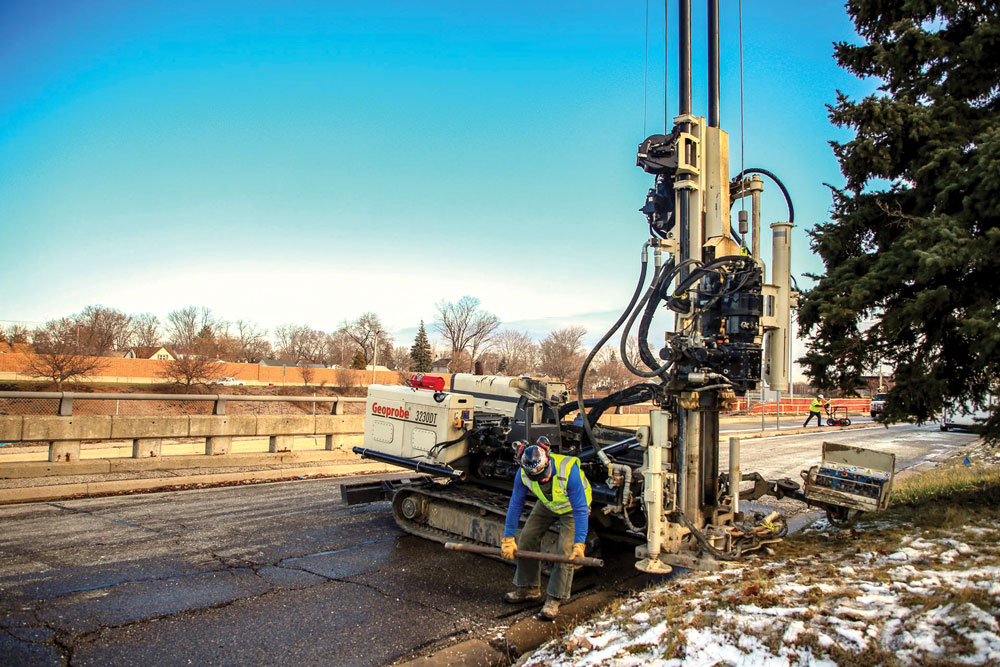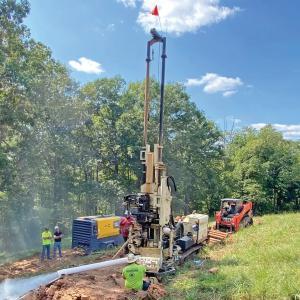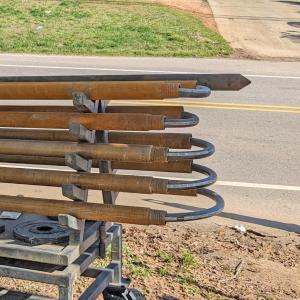
3230DT green ooze
One cold day in late December rush-hour motorists noticed green ooze gushing onto the pavement through a crack in the retaining wall of I-696, north of Detroit. That evening and into the next day, the U.S. Environmental Protection Agency (EPA) began an initial cleanup of more than 11,000 gallons of polluted rain and groundwater from inside and beside the vacant factory — a cleanup process that started back in 2016 (see timeline below).
A hand-dug hole, 10-feet square and 5-feet deep, hidden in the basement of the former metal-plating factory had collected waste chemicals, ultimately contaminating the ground.
To mitigate the situation, EPA installed a sump in the building basement and along the highway barrier to pump out the contaminated liquid. EPA also created a 90-foot long by 14-foot wide trench filled with porous material between utilities where a strategically placed sump intercepts the contaminated groundwater coursing toward the highway.
By early January, the EPA hired contractors to extract soil borings, complete Hydraulic Profiling Tool (HPT) logs, and install monitoring wells. Mannik Smith Group was on the site in Madison Heights with their Geoprobe® 3230DT and Stock Drilling used their Direct Image® HPT tooling.
"The EPA wanted us to delineate where the ooze was leaking from the building on the site," said Rob Schippert, driller with Mannik Smith Group. "We completed environmental borings to narrow in where the source was located and installed monitoring wells around the building to watch for leaks in other directions."
During the week-and-a-half on site, the 3230DT came in handy to use 4.5-inch casing with direct push instead of augers for the well installations.
"The EPA representatives on site were convinced direct push was the right way to do this job," Schippert said. "We weren't turning up soils that would have to be drummed and then disposed of. It was a whole lot cleaner process."
Early each day he'd set up the rig and there would already be a news crew on site.
"The contamination story was very well covered by the news media, until the coronavirus kicked off," Schippert said. "They're still doing clean up, but now it's not being covered."
By mid-January the EPA had collected 21 soil boring samples and eight surface soil samples. Four permanent monitoring wells and 25 temporary monitoring wells were installed. Six water samples were collected from the storm sewer and catch basins near the facility and the outlet to Bear Creek. Michigan Department of Environment, Great Lakes, and Energy (EGLE) had collected additional samples from storm sewers and from Bear Creek.
- Soil samples collected from the highway embankment, where the green ooze appeared, showed hexavalent chromium, multiple heavy metals, and other contaminants at levels below the threshold for direct human contact.
- Groundwater samples taken between the building and the highway service drive showed elevated levels of chromium, trichloroethylene (TCE) and cyanide – all chemicals previously used by the former metal-plating factory.
- Water samples collected from the storm sewer near the site showed levels of hexavalent chromium at 140 micrograms per liter (ug/L) above the 100 ug/L standard for drinking. The storm sewer eventually enters Lake St. Clair miles away.
- Water samples retrieved from the hand-dug hole contained levels of PFOS — one of the PFAS compounds — at a level more than 10 times above Michigan’s groundwater standard.
As of late March, 64 soil samples and 60 groundwater samples had been collected by EPA contractors. By early May, more than 150,000 gallons of contaminated water had been recovered from sump pumps and the interceptor trench diverting groundwater from the building.
According to the EPA website, “Although measurement of the [contaminants] are all high on the site when compared to standards, off-site and site edge measurements indicate that, at this time, contamination is largely contained by the emergency measures EPA has put in place. At this time, due to the security of the site and the measures in place there is little risk of human exposure to these chemicals. We will continue to monitor the site as we work with the state of Michigan and local partners to develop a longer-term plan to continue to protect human health and the environment for the Madison Heights community.”
INVESTIGATION TIMELINE
- 2016: After a history of repeated violations of environmental laws, the metal-plating factory was issued a Cease and Desist order from the EGLE in December due to extreme mismanagement of hazardous waste that posed an immediate and substantial threat to the community.
- 2017:EPA conducted a cleanup of the site, removing the hazardous chemicals and pumping contaminated liquid from an earthen pit in the basement of the facility. This clean-up addressed the immediate hazards on the site but was not intended to address all environmental impacts.
- 2019: A preliminary analysis of the site was completed by EGLE as part of the process to determine eligibility for EPA Superfund testing and cleanup. This identified significant contamination at the site but concluded there was no risk to drinking water and low risk for migration of contaminants off site. Thus, the site was not accepted for EPA Superfund actions and would be addressed by other cleanup authorities, including state environmental laws.
Contaminants Discovered
- Chromium: Exposure has been linked to lung, nasal, and sinus cancers, kidney and liver damage, nasal and skin irritation and ulceration, and eye irritation and damage. Hexavalent chromium detections have been in shallow groundwater which is not used as a drinking water source in the area. Therefore, there is no health risk attributed from potential ingestion of the shallow groundwater contamination.
- Cyanide: Exposure has been linked to brain and heart damage. Cyanides have been detected in the highway embankment – not accessible by the public – at levels that do not present a direct contact threat.
- TCE: Exposure may result in liver and kidney damage and/or cancer and there is some evidence that exposure to TCE can impact the development of the heart in the fetus of an exposed mother. TCE has been found in shallow groundwater above EPA and EGLE screening levels. Additional investigation is ongoing to determine if a complete exposure pathway to the public exists.
- PFAS: polyfluoroalkyl substances are manmade chemicals used in a variety of industrial and consumer products, such as carpeting, clothing, upholstery, food paper wrappings and fire-fighting foams. Exposure has been linked to reproductive and developmental, liver and kidney, and immunological effects, increased cholesterol levels, low infant birth weights, cancer (for PFOA), and thyroid hormone disruption (for PFOS). PFOS was found in the hand-dug hole within the old building. EPA disclaimer: Sampling results are considered preliminary until data validation is complete. Data validation is ongoing.
Contact Us
1835 Wall Street
Salina, Kansas 67401
Phone: (785) 825-1842
Photo Gallery


Related Articles
Double breakout on the 3230DT shines on a unique geothermal energy loop project.
ID: 14605 | Date:
Multifunctional 3230DT provides power for additional depth with ability to quickly switch between drilling methods to achieve efficient completion of mining sector projects.
ID: 14359 | Date:
The East Coast Service Team works hard to keep companies like Odyssey Environmental Services in the field as much as possible.
ID: 14031 | Date:
Geoprobe® manufactures high quality tooling by listening to customer feedback and continuing to innovate.
ID: 14027 | Date:
Driller praises the power and smoothness of the 3230DT when coring rock.
ID: 14019 | Date:
Related Videos
3230DT Walkaround - Control Panel
ID: 13627
ID: 13626
Geoprobe® MD4 Display Overview
ID: 13461
ID: 5550
ID: 1955
ID: 220







